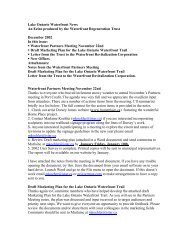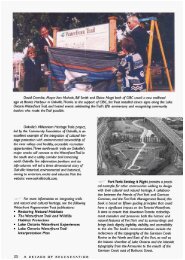Signage Guidelines - Waterfront Trail
Signage Guidelines - Waterfront Trail
Signage Guidelines - Waterfront Trail
- No tags were found...
You also want an ePaper? Increase the reach of your titles
YUMPU automatically turns print PDFs into web optimized ePapers that Google loves.
Reserved Bicycle Lane signs should be posted 15 m from thecurb radius end with the initial sign posted downstream from theroadway intersection. Signs thereafter should be spaced at 200 mintervals. Prior to the end of the cycling lane, the Reserved BicycleLane sign in conjunction with the “Ends” sign (RB-85t) should beinstalled (see Figure 3.18). In a similar fashion, the “Begins” sign(Rb-84t) may be installed in addition to Reserved Bicycle Lanesigns (see Figure 3.19).Pavement MarkingsExclusive cycling lanes are conventionally separated from otherroadway travel lanes by a painted line or retro reflective stripe withthe same “white” colour as similar roadway lane lines. Cyclinglane lines are typically solid and approximately 100-150 mmwide. It should be emphasized that solid lines do not indicate thatcyclists are restricted to cycling lanes. On the contrary, cyclists arefree to travel in other lanes as well.Figure 3.18; Source: MTO, 2000-A.Figure 3.19; Source: MTO, 2000-A.Signs for exclusive cycling lanes should be designated by aregulatory by-law for permanent use. Wherever possible thesesigns should be mounted above the lane rather than simply besidethe roadway. Reserved Bicycle Lane signs should be installed inconjunction with corresponding pavement markings.A minimum 15 m before an intersection, cycling lane lines shouldbe broken into 1.0 m long segments and 1.0 m gaps to indicatethat cyclists and motorists should merge, as required, beforereaching the intersection. Cycling lane lines should be discontinuedaltogether through intersections.Where a cycling lane is introduced mid-block betweenintersections, a broken cycling lane line should be applied aminimum 30 m from the start of the opening up of the lane.Thereafter, a solid cycling lane line can be applied to indicatethe full establishment of the cycling lane. Where a cycling laneis terminated mid-block between intersections, the cycling laneline should be broken a minimum 15 m before the lane beginsto taper.Where a cycling lane transitions onto a through lane, the solidcycling lane line should end, and a broken line ensue a minimum30 m before the start of the shared roadway. Thereafter, regularthrough lane pavement markings should follow. By treatingcycling and through lane transitions as such, both the cyclist andmotorists are made aware of the fact that they are sharing acommon lane and should act accordingly.Figures 3.20 to 3.23 illustrate signage and pavement markingsrecommended for cycling lanes occurring at intersections andmid-block between intersections. An example of a complexintersection occurring along the <strong>Waterfront</strong> <strong>Trail</strong> is located atPrudhommes where Victoria Road intersects with the North ServiceRoad and the Queen Elizabeth Way on and off-road ramps.Signed-Only Cycling Route, OttawaSource: MMM“Discontinuing the bicyclelane line or substituting abroken line for the solidbicycle lane line allows rightturningmotor vehicles tomerge right into the curb lanebefore making their turn” 11 MTO, 2000-B, p. 89.<strong>Waterfront</strong> <strong>Trail</strong> | Design, <strong>Signage</strong> and Maintenance <strong>Guidelines</strong> Update | Section 2 - <strong>Signage</strong> <strong>Guidelines</strong>2-15






